The vegetive kingdom: bread weed
Bread weed is ubiquitous across the continent of Ewlah, with species being found in most habitats. The family shows a range of morphologies and life cycles, but are considered to be among the more advanced types of vegetives. The species described below - the Shengi bread weed, one of the dominant species found throughout the Nausuu Shenguu - can be considered a typical example of the family.
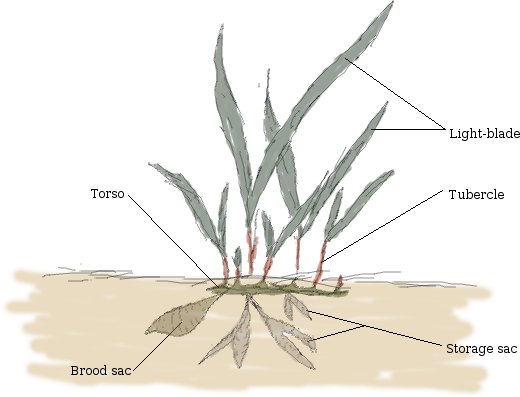
Morphologies
The Shengi bread weed is of an average size for the bread weed family, with the sessile form reaching up to around 50cm above ground and up to 70cm below ground. It prefers to grow in loose, stony soil with a thin, hard-packed surface, preferably near to a water source - though the species is capable of enduring extended periods of drought. The sessile form can live for more than 10 orbits, while the motile form rarely lasts for more than half an orbit. The organism has a more complex life cycle than many other bread weeds in that it uses other organisms to help it spread.
Both the motile and sessile form of bread weed possess a torso - a segmented tube showing both bilateral symmetry and differentiation along the its length. The flesh is organised into essential organs connected by various mass transport systems within the motile form; this organisation is much diminished in the sessile form where fibres and wood predominate.
The sessile form
The sessile form is the diploid phase in the life cycle. The torso is usually found buried in soil, and anchored within it by a series of roots and nodules emerging from the ventral side of each segment. The torso grows horizontally from each end, and in the Shengi bread weed the torso rarely branches. While other bread weeds are able to regenerate themselves assexually from just a few segments of torso, the Shengi species relies more on the motile phase for increasing its numbers.
From the dorsal side arise paired tubercles, which each in turn give rise to two blades whose primary purpose is photosynthesis and gas exchange. Movement of liquids between the torso and blade is mediated by simple, yet strong, valve pumps. The blades are routinely predated by other organisms - the Shengi bread weed combats this threat by growing thin, sharp, crystalline lances through and beyond the blade, and by regularly shedding old blades and growing new ones.
Beneath the torso can be found the storage sacs - in many ways analagous to the blades, though their purpose is rather the uptake of water and salts, excretion and storage of starches and fats. Again, they connect to the torso via tubercles; it is these sacs which are often harvested by people. The brood sacs are found beyond the main torso: some species may have a cluster of brood sacs, but the Shengi bread weed usually generates just one sac at a time and buries it deep into the soil, often beneath the level of the storage sacs.
The motile form
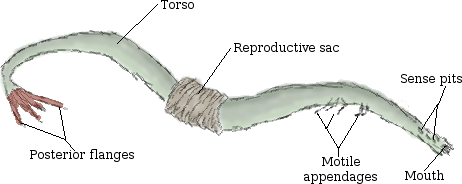
The motile form of the Shengi bread weed - known as the worm - consists of just the torso, within which can be found a number of organ systems for controling ingestion and excretion of nutrients, water and salts, movement, reproduction, gas exchange and sensing the surrounding environment. The torso can grow up to 40mm in length, but no more than 2mm in diameter. The motile form represents the haploid stage of the bread weed life cycle.
Bread weed worms live in the top 15-20 cm of the soil, and play an important role in maintaining soil structure. Their main source of food is single cell organisms - mainly microfilms and germulas, which they take in on soil particles through the mouth. Waste soil and other undigested solids are also excreted via the mouth, the intestinal tract forming a closed loop from the mouth.
Movement is achieved through contraction of sets of lateral and circumferential muscles that lie beneath the skin (in the Shengi bread weed, the motile appendages are almost vestigial and play little part in movement). The worm always moves head-first, and a number of sensory pits help control the direction of movement - the repeated contractions also help drive fluids around the torso and food through the intestinal tract. The nervous system is an uncentralised network, with each pit having its own knot of nerves directly beneath it.
Gas exchange and mineral salts balance (including uptake and excretion of water) takes place in the posterior flanges. These flanges are normally housed in a sheath cavity within the body of the torso - the Shengi bread weed has an impressive set of flanges which are often extended when the worm is otherwise at rest, or when it encounters a body of water. Other bread weed species have more complex sheath cavities lessening the need for flange extension.
Midway along the length of the torso can be found the reproductive sac, which houses the gonads and acts as the external covering of the seeds following sexual reproduction. While some species of bread weed show signs of sexual dimorphism in the motile form, the Shengi bread weed worms are all of a similar size.
Life cycle and reproduction strategies
The western constant plains habitat is notable for its relative dryness, with temperature variations marking the changing of the seasons. The Shengi bread weed undertakes meiotic reproduction in the weeks following the spring equinox, while the resulting worms sexually reproduce in the weeks leading up to the autumn equinox after spending the summer months foraging and growing to full size.
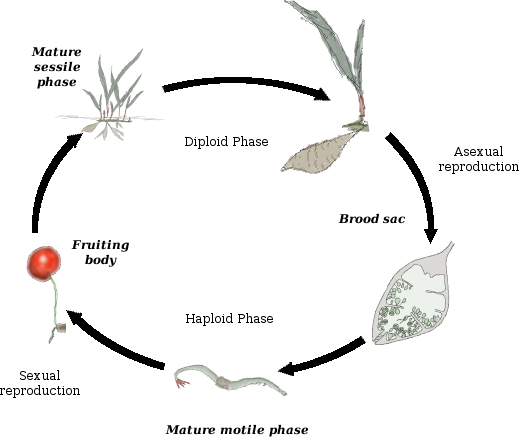
Other bread weed species are capable of vegetative assexual reproduction, with sessile forms producing new sessile organisms and motile forms similarly dividing to produce new worms. Such activity has not been reported (to date) in the Shengi bread weed.
Assexual reproduction commences in the spring when the sessile torso grows a new brood sac. Within the brood sac form a number of folds from which the meiotic sacs emerge. These sacs hold the cells that undergo meiotic division to produce haploid (one set of chromosomes) embryos, which then further develop into immature worms. As the temperature increases the brood sac opens to release the worms into the soil. Each brood sac is capable of producing up to a quarter of a million worms during the spring. Once the worms have been released, the sac will wither.
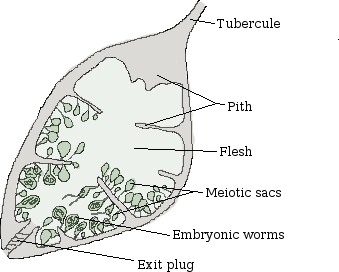
The main purpose of the worm, once released, is to grow. During the summer the worm will grow from an initial 2mm in length to around 40mm. During the late summer the surviving worms will develop their reproductive sac, after which they will divert their activities towards finding a suitable mate.
Experiments have shown that worms have a marked preference for mating with worms from unrelated weeds. For the Shengi bread weed worms, mating takes place in pairs rather than in the knots favoured by many other species of breadweed. When a suitable mate is found, the worms will push their heads into their opposite number's reproductive sac, where the exchange of gametes takes place.
Once mating has taken place, each worm will disengage and seek out a place to complete the life cycle. Once a suitable location has been found - preferably in good, slightly moist soil - the worm stops moving and turns its attention to producing the fruiting bodies which contain the diploid embryo.
Shengi bread weed worms routinely produce between three to eight fruiting bodies, each growing to the surface from the reproductive sac. As the fruiting bodies mature, the worm's torso will lengthen and whither - its only purpose now is to help anchor the fruiting body in the soil. The fruiting body itself is made of swollen haploid cells surrounding a hard, woody seed within which can be found the new embryo. Note that many bread weed species do not produce a fruiting body, but rather sacrifice the worm to give the new embryo nutrition while it produces its first light blades.
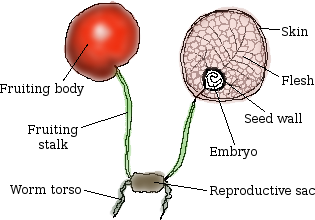
The fruiting body is intended to be eaten, and a number of vermic and chimeric organisms will feast on the fruiting bodies as they emerge from the ground each autumn - as do humans and goats, hence the alternative name for the Shengi bread weed's fruiting body: ground cherries. The seed within the fruiting body is tough enough to pass through most organisms unharmed by the digestion process, emerging with the faeces. Only at this point will the seed germinate, allowing the new weed to make use of the nutrients and water in the faeces to help it grow quickly - a new weed will have more chance of surviving the colder, drier winter if its torso reaches a length of 4cm before the winter solstice.
Additional notes
While ground cherries may be a local delicacy, they are not very nutritious. The starches and fats that bread weed species lay down in their storage sacs are a different matter, providing a good source of food (after being fermented by boucha) when Type Two plants are not available. The storage sacs - also known as bread weed tubers can often be harvested without harming the bread weed itself. The Shengi bread weed tends to produce smaller, sweeter tubers but other species are capable of growing tubers that reach a length of 50cm and a diameter of 30cm.